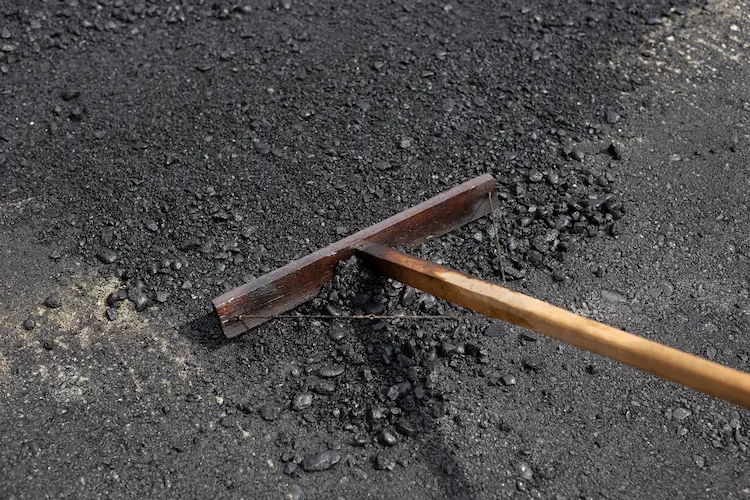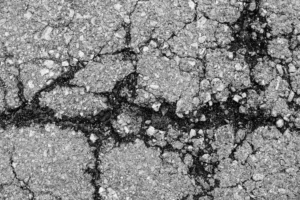Do you ever wonder why those pesky cracks keep appearing on your asphalt driveway or parking lot? Well, fear not, because this article is here to shed light on the importance of asphalt crack repair techniques.
By using the right tools and equipment, professionals can effectively seal and fill those cracks, preventing further damage and costly repairs.
So, let’s dive in and explore the various types of cracks and the best methods to fix them, ensuring the longevity of your asphalt surfaces.
Key Takeaways
- Asphalt cracks are commonly caused by water damage, the freeze-thaw cycle, heavy traffic, lack of maintenance, and poor-quality materials.
- Timely asphalt crack repair is important to prevent water infiltration, minimize further damage, increase lifespan, address underlying issues, and avoid costly resurfacing or replacement.
- Different types of asphalt cracks include alligator cracking, block cracking, edge cracking, slippage cracking, and potholes.
- Evaluating the extent of asphalt damage includes assessing crack width, crack depth, spread of cracks, and surface distress.
Common Causes of Asphalt Cracks
If you don’t properly maintain your asphalt, regular wear and tear can lead to cracks forming over time. Understanding the common causes of asphalt cracks is crucial in preventing them from occurring.
One common cause is water damage. When water seeps into the asphalt surface, it weakens the underlying layers, causing cracks to develop.
Another cause is the freeze-thaw cycle. In colder climates, water trapped in the asphalt expands when it freezes, putting pressure on the surface and resulting in cracks.
Heavy traffic is also a significant cause of asphalt cracks. The constant weight and movement of vehicles can cause the asphalt to deteriorate and eventually crack.
To prevent these cracks, regular maintenance is essential. This includes sealing any existing cracks, ensuring proper drainage to prevent water accumulation, and using quality materials during construction or repair.
Importance of Timely Asphalt Crack Repair
To ensure the longevity and durability of your asphalt, timely crack repair is crucial. Neglecting to address cracks in a timely manner can lead to further damage and costly repairs down the line.
Here are four reasons why timely asphalt crack repair is important:
- Prevents water infiltration: Cracks in asphalt allow water to seep in, causing the base material to weaken and deteriorate. Timely repairs prevent water from penetrating the surface and compromising the structural integrity of the pavement.
- Minimizes further damage: Small cracks can quickly turn into larger ones if left unattended. By addressing cracks promptly, you can prevent them from spreading and avoid more extensive damage to your asphalt.
- Increases pavement lifespan: Timely repairs extend the lifespan of your pavement. By addressing cracks early on, you can maintain the structural integrity of the asphalt and avoid the need for costly resurfacing or replacement.
- Ensures long-term solutions: Prompt crack repairs provide long-term solutions by addressing the underlying issues causing the cracks. By addressing the root cause, you can prevent recurring cracks and ensure the durability of your asphalt.
Understanding Different Types of Asphalt Cracks
You can understand different types of asphalt cracks by examining their characteristics and causes.
It is important to be able to identify these cracks as they can indicate different types of asphalt damage and signs of neglected asphalt maintenance.
To help you understand the various types of asphalt cracks, here is a table that outlines their characteristics and possible causes:
| Type of Asphalt Crack | Characteristics | Possible Causes |
|---|---|---|
| Alligator Cracking | Resembles alligator skin with interconnected cracks | Weak base, heavy traffic loads |
| Block Cracking | Cracks that form in a rectangular or square pattern | Aging asphalt, shrinkage, or poor construction |
| Edge Cracking | Cracks that form along the edges of the pavement | Insufficient support, heavy traffic, or inadequate drainage |
| Slippage Cracking | Cracks that occur when the top layer of asphalt slides over the lower layers | Poor bonding, inadequate compaction |
| Potholes | Holes formed in the pavement surface | Water damage, freeze-thaw cycles, heavy traffic |
Understanding the different types of asphalt cracks can help you determine the appropriate repair techniques and prevent further damage to your pavement.
Evaluating the Extent of Asphalt Damage
To determine the extent of asphalt damage, assess the severity and spread of cracks and other signs of deterioration. Here are some key points to consider when evaluating asphalt damage:
- Crack width: Measure the width of cracks using a ruler or crack gauge. Wide cracks indicate more significant damage.
- Crack depth: Use a probe or screwdriver to assess the depth of cracks. Deeper cracks may require more extensive repairs.
- Spread of cracks: Observe the pattern and distribution of cracks. Spreading cracks indicate underlying issues with the asphalt’s structural integrity.
- Surface distress: Look for other signs of deteriorating asphalt, such as potholes, raveling, or alligator cracking. These can indicate the need for immediate repair.
Tools and Equipment for Asphalt Crack Repair
When evaluating the extent of asphalt damage, it is important to have the right tools and equipment for efficient asphalt crack repair.
Utilizing the correct tools can make the process more effective and cost-efficient. Here is a table highlighting some essential tools and equipment for asphalt crack repair:
| Tools | Equipment |
|---|---|
| Crack cleaning tools | Asphalt crack sealer |
| Crack filling tools | Crack sealing machine |
| Hot air lance | Asphalt crack router |
| Crack sealant applicator | Crack cleaning machine |
Crack cleaning tools, such as wire brushes and blowers, are used to remove debris and vegetation from cracks. Crack-filling tools, such as pour pots and squeegees, are used to apply crack sealant. Hot air lances and asphalt crack routers are used to prepare cracks for repair.
Finally, crack sealant applicators and cleaning machines help to ensure a thorough and effective repair.
Step-by-Step Guide to DIY Asphalt Crack Repair
To begin repairing asphalt cracks on your own, gather the necessary tools and materials. Here is a step-by-step guide to help you through the crack-sealing process:
- Evaluate crack severity: Before starting the repair, assess the size and depth of the cracks. Small, hairline cracks can be easily fixed with a simple crack filler, while larger cracks may require more extensive repair measures.
- Clean the cracks: Use a wire brush or broom to remove any debris or loose material from the cracks. This will ensure proper adhesion of the repair compound.
- Apply crack filler: Use a pourable crack filler or a tube of asphalt crack sealant to fill the cracks. Start at one end and work your way to the other, ensuring the cracks are completely filled.
- Smooth the surface: Use a trowel or putty knife to smooth the surface of the repaired cracks, making it level with the surrounding asphalt.
Professional Asphalt Crack Repair Techniques
If you want to achieve professional results for asphalt crack repair, it is essential to employ the right techniques. While DIY methods can be cost-effective, hiring asphalt crack repair services can ensure a more efficient and durable solution.
Professional contractors have the expertise and specialized equipment to handle cracks of any size and severity.
They follow industry-standard techniques that involve thorough cleaning, filling, and sealing of the cracks to prevent further damage and extend the lifespan of the pavement.
By using high-quality materials and adhering to proper application methods, professionals can provide long-lasting repairs that withstand heavy traffic and harsh weather conditions.
While the professional asphalt crack repair cost may be higher than a DIY approach, it is a worthwhile investment in the longevity and appearance of your pavement.
| Professional Asphalt Crack Repair Techniques |
|---|
| Thorough cleaning of the crack |
| Filling the crack with appropriate sealant |
| Proper application techniques |
| Use of high-quality materials |
Benefits of Using Hot Pour Crack Sealants
Hot pour crack sealants offer numerous benefits for asphalt crack repair. When compared to cold-pour crack sealants, hot-pour options provide superior performance and longevity.
Here are the key advantages of using hot pour crack sealants:
- Enhanced Adhesion: Hot pour sealants have better adhesion properties, ensuring a strong bond between the sealant and the asphalt surface. This helps prevent the sealant from detaching or peeling off over time.
- Improved Flexibility: Hot pour sealants remain flexible even in extreme temperatures, expanding and contracting with the asphalt without cracking or breaking. This flexibility allows the sealant to effectively seal and protect the crack for an extended period.
- Faster Curing Time: Hot pour sealants cure quickly, reducing the downtime of the repaired area. This means that roads and parking lots can be reopened to traffic sooner, minimizing disruptions and inconvenience.
- Cost Effectiveness: Despite the higher initial cost, hot pour crack sealants offer long-term cost savings. Their durability and extended lifespan reduce the need for frequent repairs, ultimately saving money on maintenance.
Exploring Cold Pour Crack Filling Solutions
For an effective and convenient option, consider using a popular cold-pour crack-filling solution.
Cold pour crack filling involves applying a liquid asphalt emulsion directly into the cracks in the pavement. This method doesn’t require heating the material before application, making it easier and faster to use compared to hot-pour crack sealants.
One of the benefits of cold-pour crack filling is its ability to penetrate deep into the cracks, providing a strong and durable repair. It also has a longer shelf life, allowing for easy storage and future use.
However, there are some disadvantages to cold-pour crack filling. It may not be as effective for larger cracks or in areas with extreme temperature fluctuations.
Additionally, the curing time may be longer, which can affect the overall repair timeline.
Despite these drawbacks, cold pour crack filling remains a popular choice for smaller cracks and maintenance purposes.
Preventing Future Asphalt Cracks: Maintenance Tips
To prevent future asphalt cracks, regular maintenance is essential. By following these best practices for asphalt maintenance, you can ensure the longevity and durability of your pavement:
- Seal Coating: Apply a protective sealant to the asphalt surface every few years. This helps to prevent water penetration, which is a common cause of cracks.
- Proper Drainage: Ensure that the pavement has adequate drainage to prevent water from pooling on the surface. Proper grading and the installation of drains or catch basins can help with this.
- Timely Repairs: Address any cracks or potholes as soon as they appear. Prompt repairs prevent further damage and deterioration.
- Regular Cleaning: Keep the pavement clean from debris and vegetation. Regular sweeping and removal of leaves and other organic matter will prevent moisture buildup and potential cracks.
Conclusion
In conclusion, asphalt crack repair techniques are necessary to maintain the integrity and longevity of asphalt surfaces.
By addressing cracks promptly and using appropriate tools and materials, professionals can effectively prevent further damage and ensure safe and smooth surfaces.
So, why wait for the cracks to worsen when timely repair can save time, money, and potential accidents?
Take action and protect your asphalt today.



